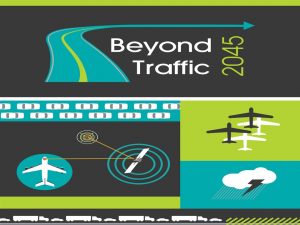 On Monday the US Department of Transportation issued a press release announcing the availability of “Beyond Traffic 2045,” the department’s framework for thinking about the next 30 years of transportation issues and challenges.
On Monday the US Department of Transportation issued a press release announcing the availability of “Beyond Traffic 2045,” the department’s framework for thinking about the next 30 years of transportation issues and challenges.
The importance of GPS to current and future transportation is sprinkled throughout the document. It is clear that, without the positioning, navigation and timing (PNT) services GPS provides, every mode of transportation would be nearly crippled. Every mode would be more congested and much slower, be able to carry less capacity, and have many more accidents.
As Department of Homeland Security (DHS) officials have repeatedly said, “GPS is a single point of failure for critical infrastructure.” This is as true for our transportation systems and infrastructure as it is for other sectors.
While it is not well highlighted, “Beyond Traffic 2045” does, after 89 pages and somewhat reluctantly, acknowledge this, and that something needs to be done:
“There are also risks to a future where transportation services depend too heavily on access to GPS-reliant applications for operations. Disruptions to service can be created by weather events, demand overload, jamming and spoofing by hackers, and excess system demand. The government agencies responsible for GPS and the transportation firms and agencies that depend on those systems are considering ways to mitigate the risks of service disruptions. This may require making decisions on how best to maintain legacy navigation systems and capabilities, and/or building targeted backup systems.”
Of course, the Department of Transportation is one of “the government agencies responsible for GPS” and is one of the many “agencies that depend on those systems [that are powered by GPS].”
And since 2004 the department has had a presidential directive to work with DHS to:
“…develop, acquire, operate, and maintain backup position, navigation, and timing capabilities that can support critical transportation, homeland security, and other critical civil and commercial infrastructure applications within the United States, in the event of a disruption of the Global Positioning System.”
We hope that, under the new administration, the Department of Transportation will finally do this and eliminate the single point of failure for, not only transportation, but all of America’s infrastructure.

